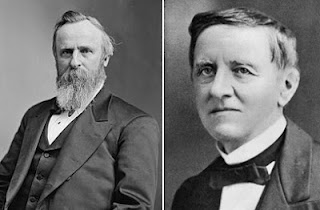1876 election disputed: The presidential election of 1876 was hotly contested. Democrat Samuel J. Tilden won a majority of the popular vote against Republican Rutherford B. Hayes. However, neither candidate had a clear majority in the Electoral College with the votes from three southern states in dispute.
 |
| Rutherford Hayes and Samuel Tilden |
Electoral Commission rules for Hayes: An electoral commission was appointed to resolve the electoral votes. It wasn’t until March 2, 1877 that the commission ruled in Hayes’ favor giving him the exact 185 electoral votes he needed for the presidency.
Early oath of office: On Saturday, March 3, 1877, Hayes took the oath of office in a private ceremony in the Red Room of the White House. He did this for a couple of reasons.
- March 4 was a Sunday: March 4, the prescribed inauguration day in the 12th Amendment to the Constitution, fell on a Sunday and so the formal oath of office and inaugural address were postponed until Monday, March 5. It had fallen on a Sunday just twice before. See my earlier blog posting on this subject.
- Transfer of power: Rather than taking the oath of office on Sunday at the expiration of Grant’s term, Hayes took the oath early because of concerns over the contested election and what Tilden’s supporters might do to disrupt the transfer of power.
- Threats against Hayes: There were reports of assassination threats against Hayes. After that after driving back with the Presidential party to the White House for a lunch with the Grant and Hayes families, Representative James Garfield wrote that “there were many indications of relief and joy that no accident had occurred on the route for there were apprehensions of assassination.” See Garfield’s diary entry for March 5, 1877.
Two presidents in one day? When Hayes took the oath of office on Saturday, March 3, it raised the thorny constitutional issue (although there is no record of it being discussed then) of whether the United States, in fact, had two presidents from March 3 (when Hayes took the oath) until March 4. President Ulysses Grant’s term of office did not expire until March 4 in accordance with the Constitution which states in Article 2, Section 1 that “he shall hold his Office during the Term of four Years.”
 |
| Ulysses Grant and Rutherford Hayes |
What if? Who was president from March 3 until March 4, Grant or Hayes? Who was in charge if something had come up needing presidential action? It wasn’t until the passage of the 20th Amendment to the Constitution in 1933 that the Constitution was made more specific about the exact time when the president’s term ended. It states that “the terms of the President and Vice President shall end at noon on the 20th day of January.”
Mike Purdy’s Presidential History Blog
© 2012 by Michael E. Purdy
www.PresidentialHistory.com

 Facebook
Facebook
 Twitter
Twitter
 LinkedIn
LinkedIn
 YouTube
YouTube
 Pinterest
Pinterest